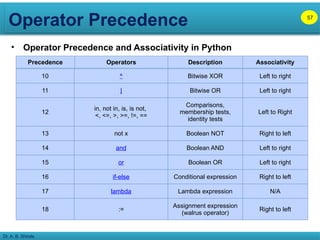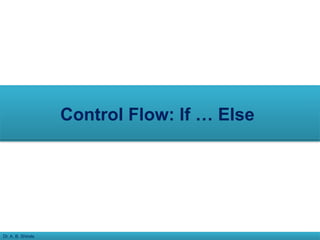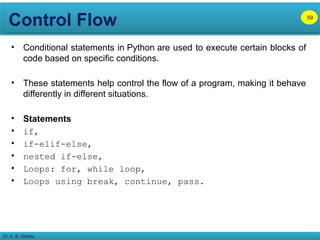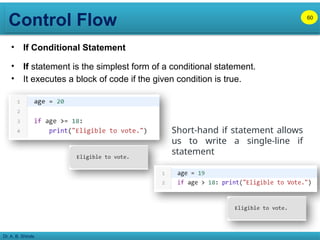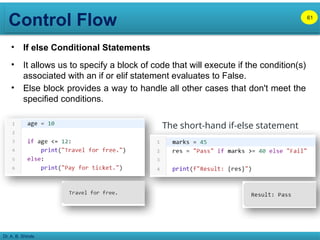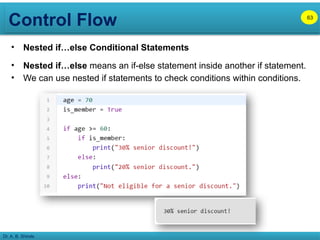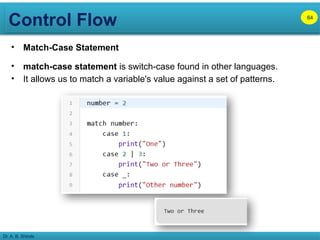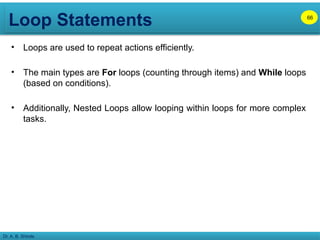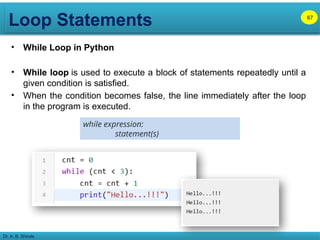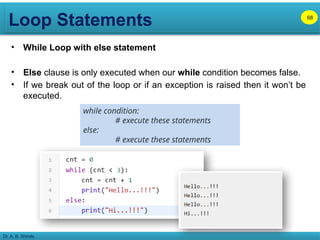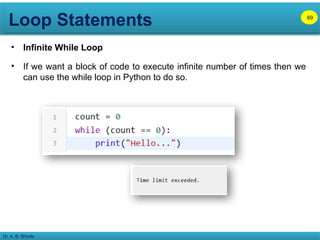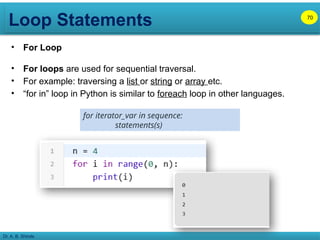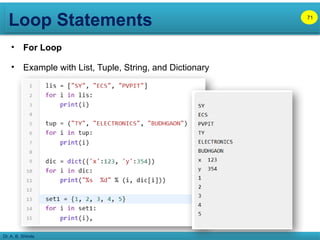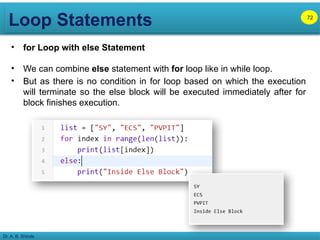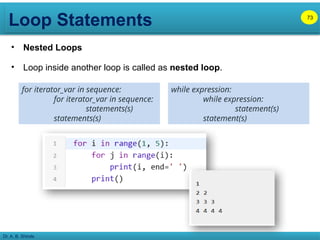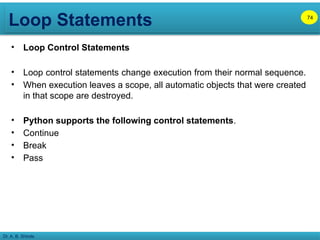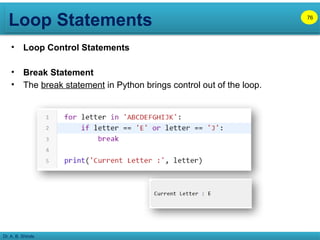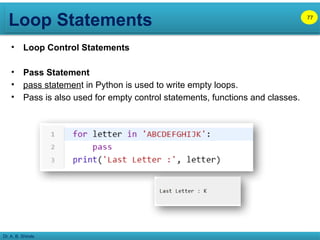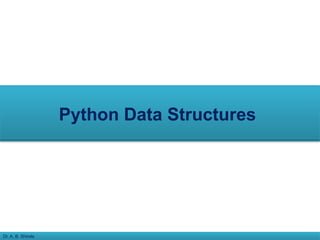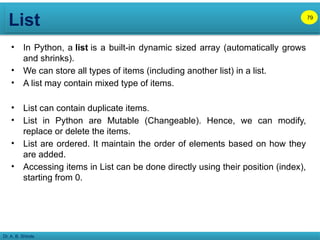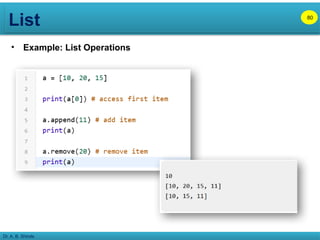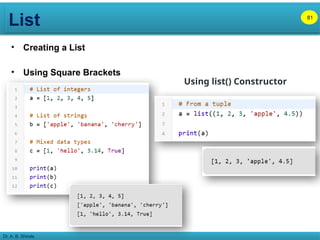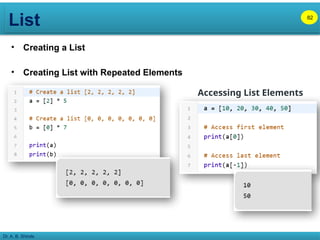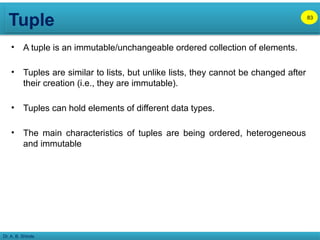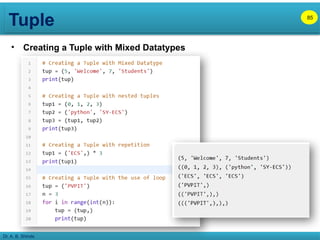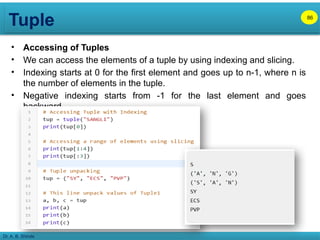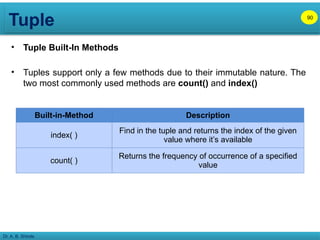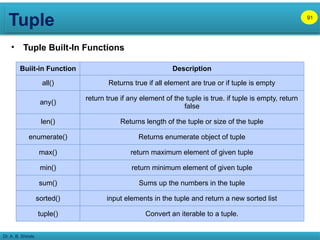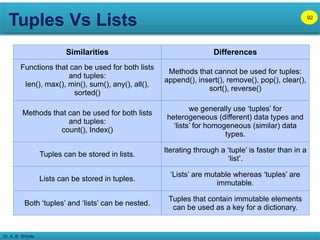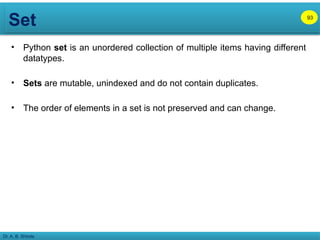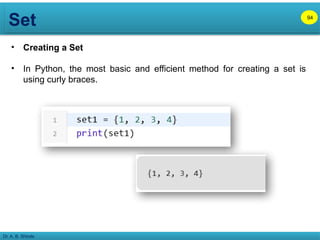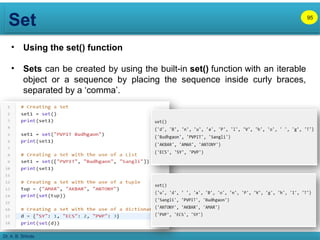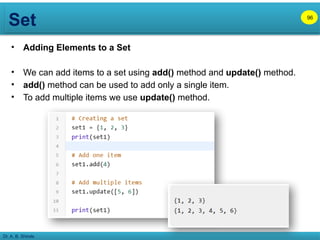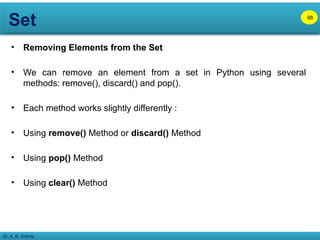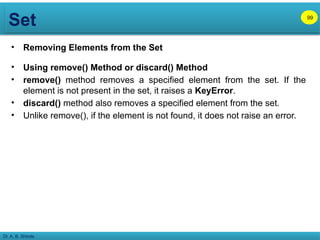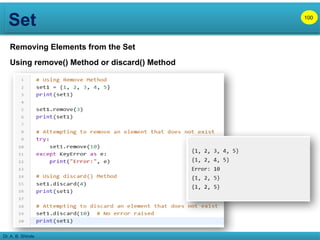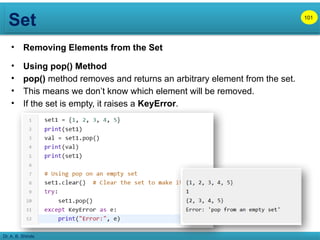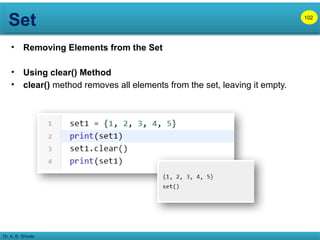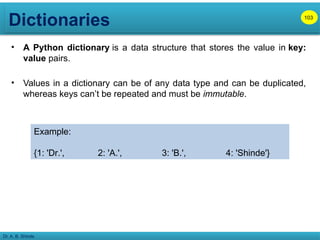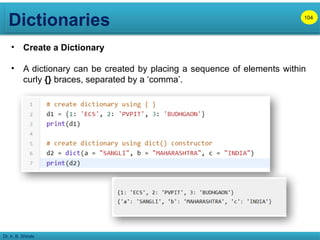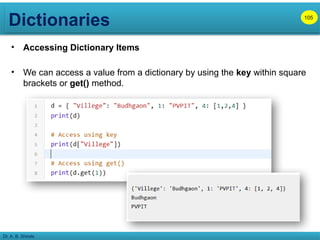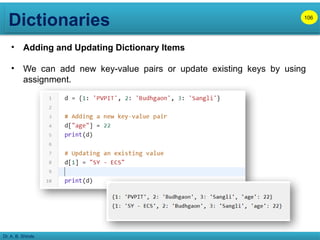Python Data Types, Operators and Control Flow
- 1. Dr. A. B. Shinde Assistant Professor, Electronics and Computer Science, P V P Institute of Technology, Sangli Data Types, Operators and Control Flow
- 2. Contents… Dr. A. B. Shinde • Python Data Types: Numbers, Strings, Sequences, Declaration and Initialization. • Operators in Python: Arithmetic, Relational, Assignment, Logical, Bitwise, Membership, Identity, Operator Precedence & Associativity. • Control Flow- if, if-elif-else, nested if-else, Loops: for, while loop, Loops using break, continue, pass. • Python Data Structures: List, Tuple, Set, Dictionary, Slicing and Comprehension operations using sequences. 2
- 3. Python Data Types Dr. A. B. Shinde
- 4. Python Data Types Dr. A. B. Shinde • Python offers versatile collections of data types, including lists, string, tuples, sets, dictionaries and arrays. • The Python data types are as follows: 4
- 5. Data Types: Numeric Dr. A. B. Shinde
- 6. Numeric Data Types Dr. A. B. Shinde • Numeric Data: • Integers – This value is represented by int class. It contains positive or negative whole numbers (without fractions or decimals). In Python, there is no limit to how long an integer value can be. • Float – This value is represented by the float class. It is a real number with a floating-point representation. It is specified by a decimal point. • Complex Numbers – A complex number is represented by a complex class. It is specified as (real part) + (imaginary part)j. 6
- 7. Numeric Data Types Dr. A. B. Shinde • Numeric Data: Integer • This is the whole number, including negative numbers but not fractions. • In Python, there is no limit to how long an integer value can be. 7 x = 10 # A positive integer y = -13 # A negative integer z = 0 # Zero is also considered an integer
- 8. Numeric Data Types Dr. A. B. Shinde • Numeric Data: Integer operations 8
- 9. Numeric Data Types Dr. A. B. Shinde • Numeric Data: Float • This is a real number with a floating-point representation. It is specified by a decimal point. • Optionally, the character e or E followed by a positive or negative integer may be appended to specify scientific notation. • Examples: 0.5 and -7.823457. • They can be created directly by entering a number with a decimal point. 9 a = 3.14 # A positive float b = -0.99 # A negative float c = 0.0 # A float value that represents zero
- 10. Numeric Data Types Dr. A. B. Shinde • Numeric Data: Float Operations 10
- 11. Numeric Data Types Dr. A. B. Shinde • Numeric Data: Complex • A complex number is a number that consists of real and imaginary parts. • Example: 2 + 3j is a complex number where 2 is the real component, and 3 multiplied by j is an imaginary part. 11
- 12. Numeric Data Types Dr. A. B. Shinde • Numeric Data: Complex Operations 12
- 13. Numeric Data Types Dr. A. B. Shinde • Type Conversion: 13
- 14. Data Types: String Dr. A. B. Shinde
- 15. String Data Types Dr. A. B. Shinde • A string is a sequence of characters. • Python treats anything inside quotes as a string. • This includes letters, numbers, and symbols. • Python has no character data type so single character is a string of length 1. 15
- 16. String Data Types Dr. A. B. Shinde • Creating a String • Strings can be created using either single (‘) or double (“) quotes. 16
- 17. String Data Types Dr. A. B. Shinde • Multi-line Strings • If we need a string to span multiple lines then we can use triple quotes (”’ or “””). 17
- 18. String Data Types Dr. A. B. Shinde • Accessing characters in String • Strings in Python are sequences of characters, so we can access individual characters using indexing. • Strings are indexed starting from 0 and -1 from end. • This allows us to retrieve specific characters from the string. 18 Positive Indexing Negative Indexing
- 19. String Data Types Dr. A. B. Shinde 19 • String Slicing: • Slicing is a way to extract portion of a string by specifying the start and end indexes. • The syntax for slicing is string[start:end], where start starting index and end is stopping index (excluded).
- 20. Python Operators Dr. A. B. Shinde
- 21. Operators in Python Dr. A. B. Shinde • Arithmetic, • Relational, • Assignment, • Logical, • Bitwise, • Membership, • Identity, • Operator Precedence & Associativity. 21
- 22. Arithmetic Operators Dr. A. B. Shinde • Arithmetic Operators in Python • Operators are fundamental for performing mathematical calculations. • Arithmetic operators are symbols used to perform mathematical operations on numerical values. • Arithmetic operators include – addition (+), – subtraction (-), – multiplication (*), – division (/), and – modulus (%). 22
- 23. Arithmetic Operators Dr. A. B. Shinde • Arithmetic Operators in Python 23 Operator Description Syntax + Addition: adds two operands x + y – Subtraction: subtracts two operands x – y * Multiplication: multiplies two operands x * y / Division (float): divides the first operand by the second x / y // Division (floor): divides the first operand by the second x // y % Modulus: returns the remainder when the first operand is divided by the second x % y ** Power: Returns first raised to power second x ** y
- 24. Arithmetic Operators Dr. A. B. Shinde • Arithmetic Operators in Python 24
- 25. Relational Operators Dr. A. B. Shinde • Relational/Comparison operators are used to compare the values of two operands (elements being compared). • When comparing strings, the comparison is based on the alphabetical order of their characters (lexicographic order). 25 Operator Description Syntax > Greater than: True if the left operand is greater than the right x > y < Less than: True if the left operand is less than the right x < y == Equal to: True if both operands are equal x == y != Not equal to: True if operands are not equal x != y >= Greater than or equal to: True if the left operand is greater than or equal to the right x >= y <= Less than or equal to: True if the left operand is less than or equal to the right x <= y
- 26. Relational Operators Dr. A. B. Shinde 26 Inequality Operators a != b Equality Operators a == b
- 27. Relational Operators Dr. A. B. Shinde 27 Greater than Sign a > b Less than Sign a < b Greater than or Equal to Sign x >= y Less than or Equal to Sign x <= y
- 28. Relational Operators Dr. A. B. Shinde • Chaining Comparison Operators • Chaining comparison operators is used to check multiple conditions in a single expression. • One simple way of solving multiple conditions is by using Logical Operators. 28
- 29. Assignment Operators Dr. A. B. Shinde 29 Assignment Operators Addition Assignment Operator
- 30. Assignment Operators Dr. A. B. Shinde 30 Subtraction Assignment Operator Multiplication Assignment Operator
- 31. Assignment Operators Dr. A. B. Shinde 31 Division Assignment Operator Modulus Assignment Operator
- 32. Assignment Operators Dr. A. B. Shinde 32 Floor Division Assignment Operator It is used to divide the left operand with the right operand and then assigs the result(floor value) to the left operand. Exponentiation Assignment Operator
- 33. Logical Operators Dr. A. B. Shinde • Logical operators are used to combine conditional statements, allowing you to perform operations based on multiple conditions. • Logical operators are used on conditional statements (either True or False). • They perform Logical AND, Logical OR, and Logical NOT operations. 33 Operator Description Syntax Example and Returns True if both the operands are true x and y x>7 and x>10 or Returns True if either of the operands is true x or y x<7 or x>15 not Returns True if the operand is false not x not(x>7 and x> 10)
- 34. Logical Operators Dr. A. B. Shinde • Truth Table for Logical Operators 34
- 35. Logical Operators Dr. A. B. Shinde • Logical AND operation 35
- 36. Logical Operators Dr. A. B. Shinde • Logical OR operation 36
- 37. Logical Operators Dr. A. B. Shinde • Logical NOT Operation 37
- 38. Bitwise Operators Dr. A. B. Shinde • Python bitwise operators are used to perform bitwise calculations on integers. • The integers are first converted into binary and then operations are performed on each bit or corresponding pair of bits, hence the name bitwise operators. • The result is then returned in decimal format. 38 Operator Description Syntax & Bitwise AND x & y | Bitwise OR x | y ~ Bitwise NOT ~x ^ Bitwise XOR x ^ y >> Bitwise right shift x>> << Bitwise left shift x<<
- 39. Bitwise Operators Dr. A. B. Shinde • Bitwise AND Operator • Bitwise AND (&) operator takes two equal-length bit patterns as parameters. • The two-bit integers are compared. • If the bits in the compared positions of the bit patterns are 1, then the resulting bit is 1. If not, it is 0. 39
- 40. Bitwise Operators Dr. A. B. Shinde 40 Bitwise AND Operator Bitwise OR Operator
- 41. Bitwise Operators Dr. A. B. Shinde 41 Bitwise XOR Operator Bitwise NOT Operator
- 42. Bitwise Operators Dr. A. B. Shinde • Bitwise Shift • These operators are used to shift the bits of a number left or right thereby multiplying or dividing the number by two respectively. • They can be used when we have to multiply or divide a number by two. 42
- 43. Bitwise Operators Dr. A. B. Shinde • Bitwise Right Shift • Shifts the bits of the number to the right and fills 0 on voids left (fills 1 in the case of a negative number) as a result. • Similar effect as of dividing the number with some power of two. 43 Example: a = 10 = 0000 1010 (Binary) a >> 1 = 0000 0101 = 5
- 44. Bitwise Operators Dr. A. B. Shinde 44 Bitwise Right Shift
- 45. Bitwise Operators Dr. A. B. Shinde • Bitwise Left Shift • Shifts the bits of the number to the left and fills 0 on voids right as a result. • Similar effect as of multiplying the number with some power of two. 45 Example: a = 5 = 0000 0101 (Binary) a << 1 = 0000 1010 = 10 a << 2 = 0001 0100 = 20
- 46. Bitwise Operators Dr. A. B. Shinde 46 Bitwise Left Shift
- 47. Membership Operators Dr. A. B. Shinde • The membership operators test for the membership of an object in a sequence, such as strings, lists, or tuples. • Python offers two membership operators to check or validate the membership of a value. • IN Operator • NOT IN Operator 47
- 48. Membership Operators Dr. A. B. Shinde • IN Operator • The in operator is used to check if a character/substring/element exists in a sequence or not. • Evaluate to True if it finds the specified element in a sequence otherwise False. 48
- 49. Membership Operators Dr. A. B. Shinde • NOT IN Operator • The ‘not in’ operator evaluates to True if it does not find the variable in the specified sequence and False otherwise. 49
- 50. Identity Operators Dr. A. B. Shinde • Identity Operators • The Identity Operators are used to compare the objects if both the objects are actually of the same data type and share the same memory location. • There are different identity operators: • IS Operator • IS NOT Operator 50
- 51. Identity Operators Dr. A. B. Shinde • IS Operator • The is operator evaluates to True if the variables on either side of the operator point to the same object in the memory and false otherwise. 51
- 52. Identity Operators Dr. A. B. Shinde • IS NOT Operator • The is not operator evaluates True if both variables on the either side of the operator are not the same object in the memory location otherwise it evaluates False 52
- 53. Operator Precedence Dr. A. B. Shinde • Operator Precedence 53 10 + 20 * 30 is calculated as 10 + (20 * 30) and not as (10 + 20) * 30
- 54. Operator Associativity Dr. A. B. Shinde • Associativity of Operators • If an expression contains two or more operators with the same precedence then Operator Associativity is used to determine. • It can either be Left to Right or from Right to Left. 54
- 55. Operator Associativity Dr. A. B. Shinde • Associativity of Operators 55
- 56. Operator Precedence Dr. A. B. Shinde • Operator Precedence and Associativity in Python 56 Precedence Operators Description Associativity 1 () Parentheses Left to right 2 x[index], x[index:index] Subscription, slicing Left to right 3 await x Await expression N/A 4 ** Exponentiation Right to left 5 +x, -x, ~x Positive, negative, bitwise NOT Right to left 6 *, @, /, //, % Multiplication, matrix, division, floor division, remainder Left to right 7 +, – Addition and subtraction Left to right 8 <<, >> Shifts Left to right 9 & Bitwise AND Left to right
- 57. Operator Precedence Dr. A. B. Shinde • Operator Precedence and Associativity in Python 57 10 ^ Bitwise XOR Left to right 11 | Bitwise OR Left to right 12 in, not in, is, is not, <, <=, >, >=, !=, == Comparisons, membership tests, identity tests Left to Right 13 not x Boolean NOT Right to left 14 and Boolean AND Left to right 15 or Boolean OR Left to right 16 if-else Conditional expression Right to left 17 lambda Lambda expression N/A 18 := Assignment expression (walrus operator) Right to left Precedence Operators Description Associativity
- 58. Control Flow: If … Else Dr. A. B. Shinde
- 59. Control Flow Dr. A. B. Shinde • Conditional statements in Python are used to execute certain blocks of code based on specific conditions. • These statements help control the flow of a program, making it behave differently in different situations. • Statements • if, • if-elif-else, • nested if-else, • Loops: for, while loop, • Loops using break, continue, pass. 59
- 60. Control Flow Dr. A. B. Shinde • If Conditional Statement • If statement is the simplest form of a conditional statement. • It executes a block of code if the given condition is true. 60 Short-hand if statement allows us to write a single-line if statement
- 61. Control Flow Dr. A. B. Shinde • If else Conditional Statements • It allows us to specify a block of code that will execute if the condition(s) associated with an if or elif statement evaluates to False. • Else block provides a way to handle all other cases that don't meet the specified conditions. 61 The short-hand if-else statement
- 62. Control Flow Dr. A. B. Shinde • elif Statement • elif statement stands for "else if." • It allows us to check multiple conditions, providing a way to execute different blocks of code based on which condition is true. • Using elif statements makes our code more readable and efficient by eliminating the need for multiple nested if statements. 62
- 63. Control Flow Dr. A. B. Shinde • Nested if…else Conditional Statements • Nested if…else means an if-else statement inside another if statement. • We can use nested if statements to check conditions within conditions. 63
- 64. Control Flow Dr. A. B. Shinde • Match-Case Statement • match-case statement is switch-case found in other languages. • It allows us to match a variable's value against a set of patterns. 64
- 65. Control Flow: Loop Statements Dr. A. B. Shinde
- 66. Loop Statements Dr. A. B. Shinde • Loops are used to repeat actions efficiently. • The main types are For loops (counting through items) and While loops (based on conditions). • Additionally, Nested Loops allow looping within loops for more complex tasks. 66
- 67. Loop Statements Dr. A. B. Shinde • While Loop in Python • While loop is used to execute a block of statements repeatedly until a given condition is satisfied. • When the condition becomes false, the line immediately after the loop in the program is executed. 67 while expression: statement(s)
- 68. Loop Statements Dr. A. B. Shinde • While Loop with else statement • Else clause is only executed when our while condition becomes false. • If we break out of the loop or if an exception is raised then it won’t be executed. 68 while condition: # execute these statements else: # execute these statements
- 69. Loop Statements Dr. A. B. Shinde • Infinite While Loop • If we want a block of code to execute infinite number of times then we can use the while loop in Python to do so. 69
- 70. Loop Statements Dr. A. B. Shinde • For Loop • For loops are used for sequential traversal. • For example: traversing a list or string or array etc. • “for in” loop in Python is similar to foreach loop in other languages. 70 for iterator_var in sequence: statements(s)
- 71. Loop Statements Dr. A. B. Shinde • For Loop • Example with List, Tuple, String, and Dictionary 71
- 72. Loop Statements Dr. A. B. Shinde • for Loop with else Statement • We can combine else statement with for loop like in while loop. • But as there is no condition in for loop based on which the execution will terminate so the else block will be executed immediately after for block finishes execution. 72
- 73. Loop Statements Dr. A. B. Shinde • Nested Loops • Loop inside another loop is called as nested loop. 73 for iterator_var in sequence: for iterator_var in sequence: statements(s) statements(s) while expression: while expression: statement(s) statement(s)
- 74. Loop Statements Dr. A. B. Shinde • Loop Control Statements • Loop control statements change execution from their normal sequence. • When execution leaves a scope, all automatic objects that were created in that scope are destroyed. • Python supports the following control statements. • Continue • Break • Pass 74
- 75. Loop Statements Dr. A. B. Shinde • Loop Control Statements • Continue Statement • The continue statement in Python returns the control to the beginning of the loop. 75
- 76. Loop Statements Dr. A. B. Shinde • Loop Control Statements • Break Statement • The break statement in Python brings control out of the loop. 76
- 77. Loop Statements Dr. A. B. Shinde • Loop Control Statements • Pass Statement • pass statement in Python is used to write empty loops. • Pass is also used for empty control statements, functions and classes. 77
- 78. Python Data Structures Dr. A. B. Shinde
- 79. List Dr. A. B. Shinde • In Python, a list is a built-in dynamic sized array (automatically grows and shrinks). • We can store all types of items (including another list) in a list. • A list may contain mixed type of items. • List can contain duplicate items. • List in Python are Mutable (Changeable). Hence, we can modify, replace or delete the items. • List are ordered. It maintain the order of elements based on how they are added. • Accessing items in List can be done directly using their position (index), starting from 0. 79
- 80. List Dr. A. B. Shinde • Example: List Operations 80
- 81. List Dr. A. B. Shinde • Creating a List • Using Square Brackets 81 Using list() Constructor
- 82. List Dr. A. B. Shinde • Creating a List • Creating List with Repeated Elements 82 Accessing List Elements
- 83. Tuple Dr. A. B. Shinde • A tuple is an immutable/unchangeable ordered collection of elements. • Tuples are similar to lists, but unlike lists, they cannot be changed after their creation (i.e., they are immutable). • Tuples can hold elements of different data types. • The main characteristics of tuples are being ordered, heterogeneous and immutable 83
- 84. Tuple Dr. A. B. Shinde • Creating a Tuple • A tuple is created by placing all the items inside parentheses (), separated by commas. • A tuple can have any number of items and they can be of different data types 84
- 85. Tuple Dr. A. B. Shinde • Creating a Tuple with Mixed Datatypes 85
- 86. Tuple Dr. A. B. Shinde • Accessing of Tuples • We can access the elements of a tuple by using indexing and slicing. • Indexing starts at 0 for the first element and goes up to n-1, where n is the number of elements in the tuple. • Negative indexing starts from -1 for the last element and goes backward 86
- 87. Tuple Dr. A. B. Shinde • Concatenation of Tuples • Tuples can be concatenated using the + operator. • This operation combines two or more tuples to create a new tuple 87
- 88. Tuple Dr. A. B. Shinde • Slicing of Tuple • Slicing a tuple means creating a new tuple from a subset of elements of the original tuple. 88
- 89. Tuple Dr. A. B. Shinde • Deleting a Tuple • Since tuples are immutable, we cannot delete individual elements of a tuple. • However, we can delete an entire tuple using del statement. 89
- 90. Tuple Dr. A. B. Shinde • Tuple Built-In Methods • Tuples support only a few methods due to their immutable nature. The two most commonly used methods are count() and index() 90 Built-in-Method Description index( ) Find in the tuple and returns the index of the given value where it’s available count( ) Returns the frequency of occurrence of a specified value
- 91. Tuple Dr. A. B. Shinde • Tuple Built-In Functions 91 Buiit-in Function Description all() Returns true if all element are true or if tuple is empty any() return true if any element of the tuple is true. if tuple is empty, return false len() Returns length of the tuple or size of the tuple enumerate() Returns enumerate object of tuple max() return maximum element of given tuple min() return minimum element of given tuple sum() Sums up the numbers in the tuple sorted() input elements in the tuple and return a new sorted list tuple() Convert an iterable to a tuple.
- 92. Tuples Vs Lists Dr. A. B. Shinde Similarities Differences Functions that can be used for both lists and tuples: len(), max(), min(), sum(), any(), all(), sorted() Methods that cannot be used for tuples: append(), insert(), remove(), pop(), clear(), sort(), reverse() Methods that can be used for both lists and tuples: count(), Index() we generally use ‘tuples’ for heterogeneous (different) data types and ‘lists’ for homogeneous (similar) data types. Tuples can be stored in lists. Iterating through a ‘tuple’ is faster than in a ‘list’. Lists can be stored in tuples. ‘Lists’ are mutable whereas ‘tuples’ are immutable. Both ‘tuples’ and ‘lists’ can be nested. Tuples that contain immutable elements can be used as a key for a dictionary. 92
- 93. Set Dr. A. B. Shinde • Python set is an unordered collection of multiple items having different datatypes. • Sets are mutable, unindexed and do not contain duplicates. • The order of elements in a set is not preserved and can change. 93
- 94. Set Dr. A. B. Shinde • Creating a Set • In Python, the most basic and efficient method for creating a set is using curly braces. 94
- 95. Set Dr. A. B. Shinde • Using the set() function • Sets can be created by using the built-in set() function with an iterable object or a sequence by placing the sequence inside curly braces, separated by a ‘comma’. 95
- 96. Set Dr. A. B. Shinde • Adding Elements to a Set • We can add items to a set using add() method and update() method. • add() method can be used to add only a single item. • To add multiple items we use update() method. 96
- 97. Set Dr. A. B. Shinde • Accessing a Set • We can loop through a set to access set items as set is unindexed and do not support accessing elements by indexing. • Also we can use in keyword which is membership operator to check if an item exists in a set. 97
- 98. Set Dr. A. B. Shinde • Removing Elements from the Set • We can remove an element from a set in Python using several methods: remove(), discard() and pop(). • Each method works slightly differently : • Using remove() Method or discard() Method • Using pop() Method • Using clear() Method 98
- 99. Set Dr. A. B. Shinde • Removing Elements from the Set • Using remove() Method or discard() Method • remove() method removes a specified element from the set. If the element is not present in the set, it raises a KeyError. • discard() method also removes a specified element from the set. • Unlike remove(), if the element is not found, it does not raise an error. 99
- 100. Set Dr. A. B. Shinde 100 Removing Elements from the Set Using remove() Method or discard() Method
- 101. Set Dr. A. B. Shinde • Removing Elements from the Set • Using pop() Method • pop() method removes and returns an arbitrary element from the set. • This means we don’t know which element will be removed. • If the set is empty, it raises a KeyError. 101
- 102. Set Dr. A. B. Shinde • Removing Elements from the Set • Using clear() Method • clear() method removes all elements from the set, leaving it empty. 102
- 103. Dictionaries Dr. A. B. Shinde • A Python dictionary is a data structure that stores the value in key: value pairs. • Values in a dictionary can be of any data type and can be duplicated, whereas keys can’t be repeated and must be immutable. 103 Example: {1: 'Dr.', 2: 'A.', 3: 'B.', 4: 'Shinde'}
- 104. Dictionaries Dr. A. B. Shinde • Create a Dictionary • A dictionary can be created by placing a sequence of elements within curly {} braces, separated by a ‘comma’. 104
- 105. Dictionaries Dr. A. B. Shinde • Accessing Dictionary Items • We can access a value from a dictionary by using the key within square brackets or get() method. 105
- 106. Dictionaries Dr. A. B. Shinde • Adding and Updating Dictionary Items • We can add new key-value pairs or update existing keys by using assignment. 106
- 107. Dictionaries Dr. A. B. Shinde • Removing Dictionary Items • We can remove items from dictionary using the following methods: • del: Removes an item by key. • pop(): Removes an item by key and returns its value. • clear(): Empties the dictionary. • popitem(): Removes and returns the last key-value pair. 107
- 108. This presentation is published only for educational purpose Thank You… abshinde.eln@gmail.com


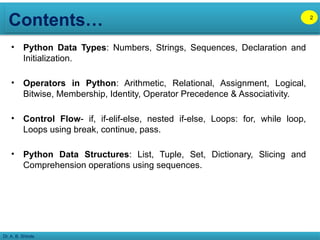
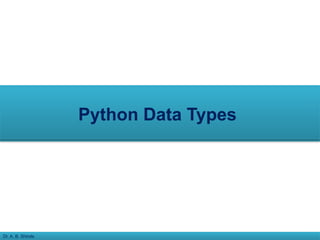
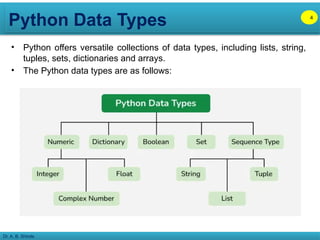
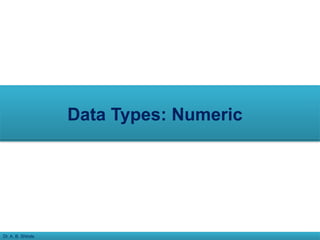
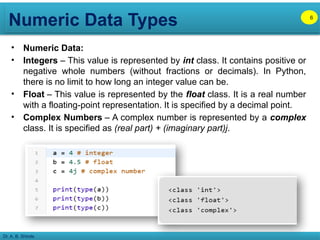
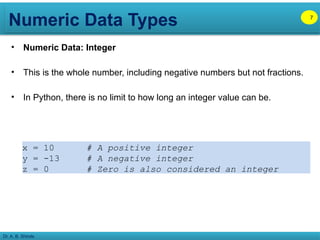
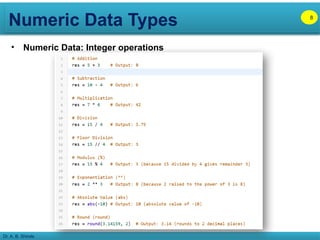
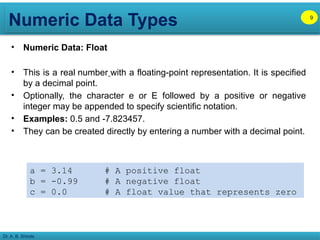
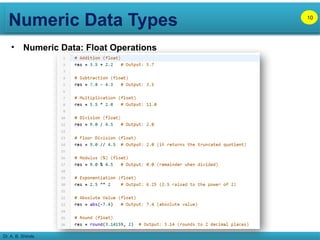
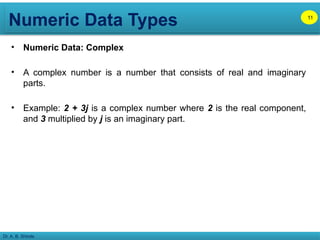
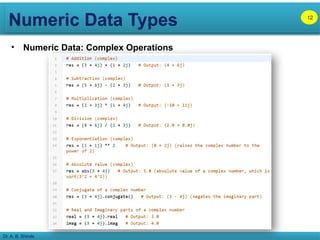

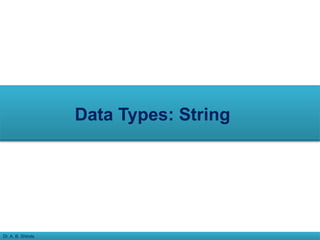
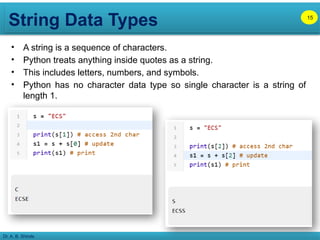
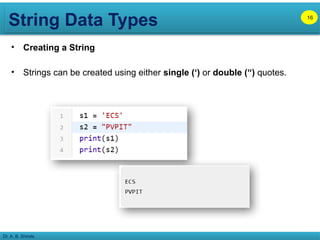
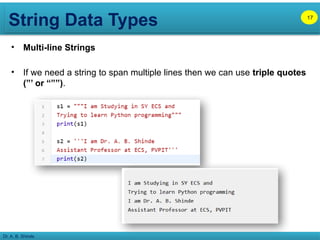
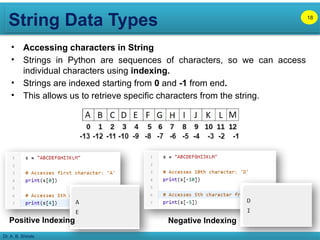
![String Data Types
Dr. A. B. Shinde
19
• String Slicing:
• Slicing is a way to extract portion of a string by specifying
the start and end indexes.
• The syntax for slicing is string[start:end], where start starting index
and end is stopping index (excluded).](https://image.slidesharecdn.com/pythondatatypesoperatorsandcontrolflow-250415062840-55b556d8/85/Python-Data-Types-Operators-and-Control-Flow-19-320.jpg)
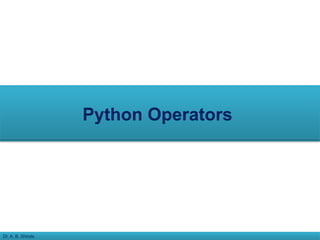
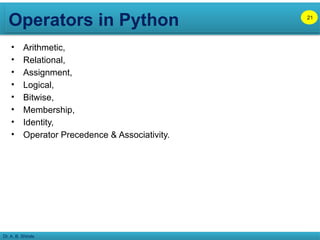

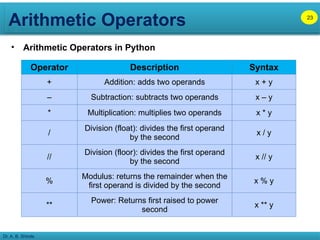

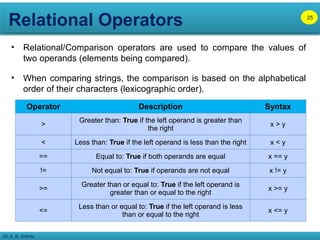
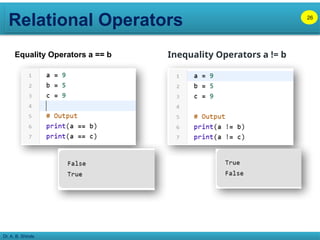
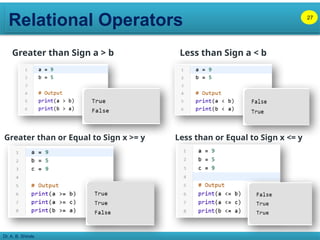
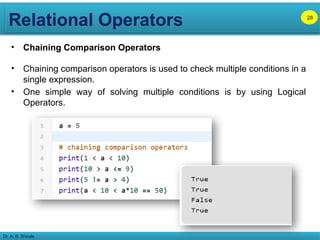
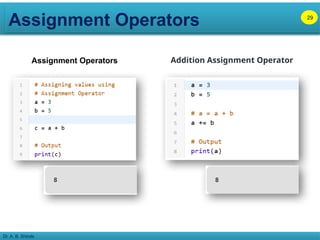
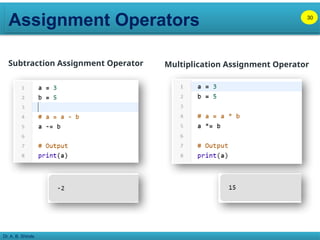

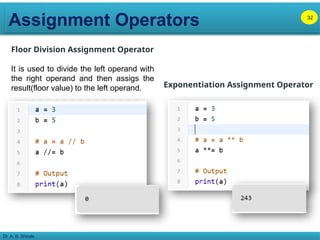
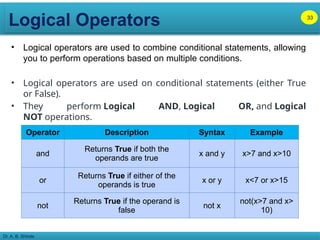
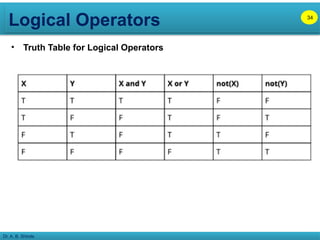
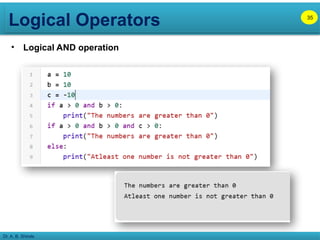
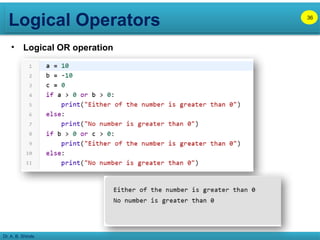
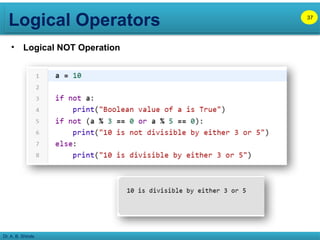
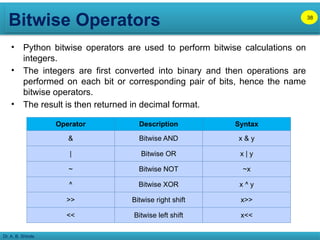
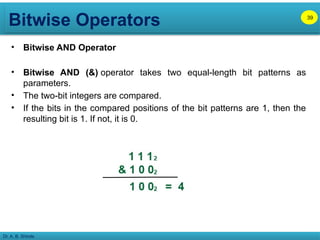
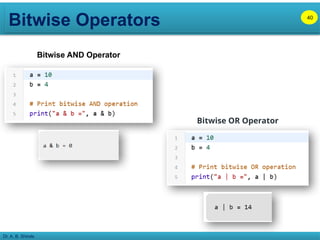
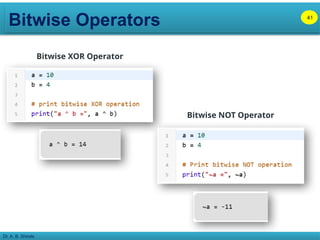
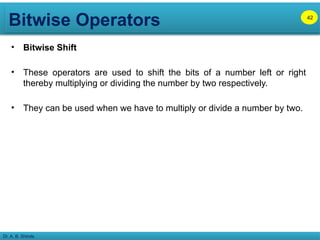
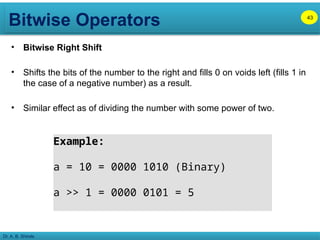
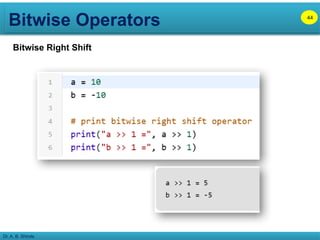
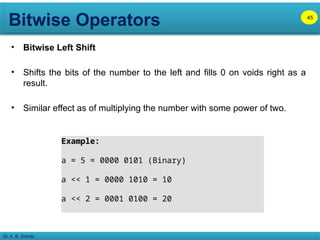

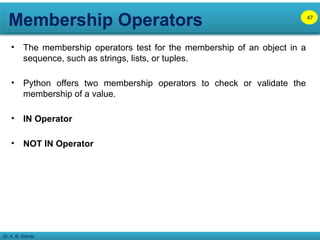
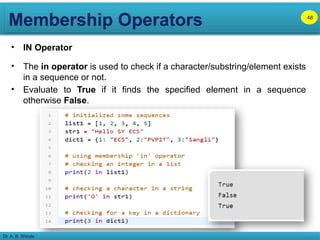
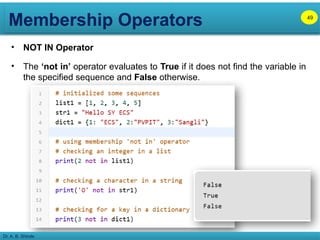
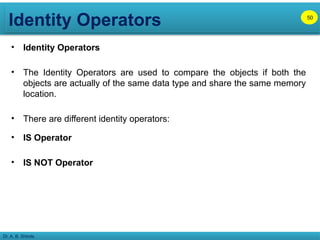
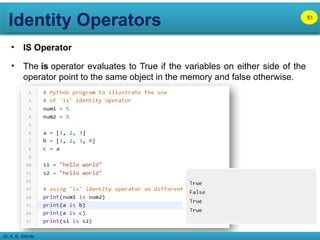

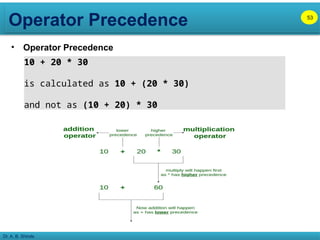

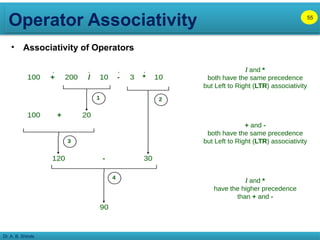
![Operator Precedence
Dr. A. B. Shinde
• Operator Precedence and Associativity in Python
56
Precedence Operators Description Associativity
1 () Parentheses Left to right
2
x[index],
x[index:index]
Subscription, slicing Left to right
3 await x Await expression N/A
4 ** Exponentiation Right to left
5 +x, -x, ~x Positive, negative, bitwise NOT Right to left
6 *, @, /, //, %
Multiplication, matrix, division,
floor division, remainder
Left to right
7 +, – Addition and subtraction Left to right
8 <<, >> Shifts Left to right
9 & Bitwise AND Left to right](https://image.slidesharecdn.com/pythondatatypesoperatorsandcontrolflow-250415062840-55b556d8/85/Python-Data-Types-Operators-and-Control-Flow-56-320.jpg)
